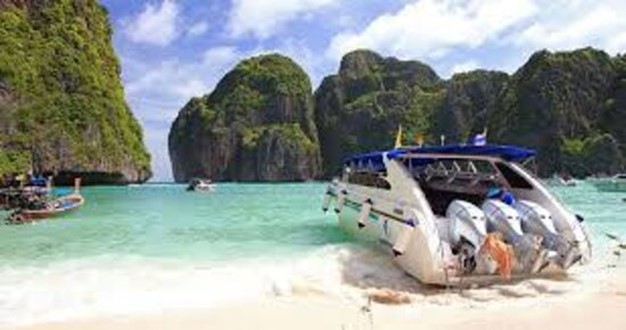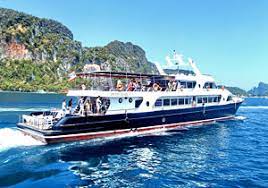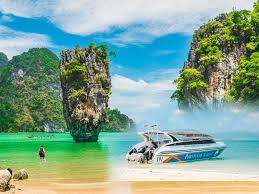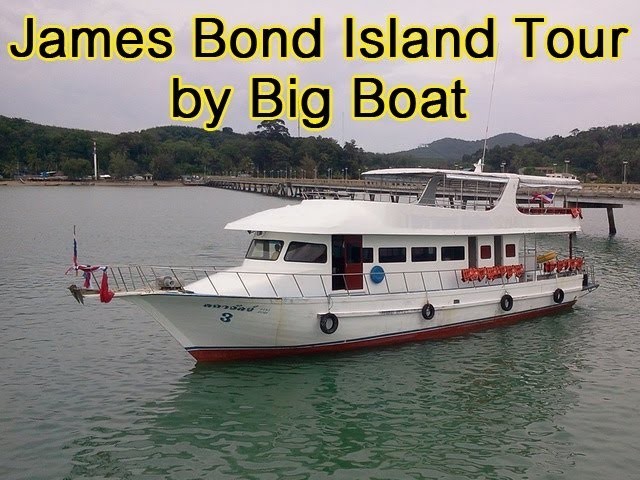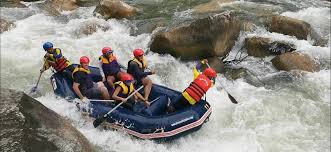Phuket Island is a
stunning combination of golden beaches, turquoise seas, green hills, mangroves,
and rainforest. Phuket lies in the Andaman Sea surrounded by beautiful islets
and to the northeast, the stunning limestone outcrops of Phang Nga Bay. Add to
this the friendly people, varied cuisine, tropical climate, and range of
amenities and you have an ideal destination for a holiday or long-term stay.
Phuket's wealth
originally came from tin mining. The tin mining boom started in the eighteenth
century and brought a wave of migrants including many Chinese to labor in the
mines. Their descendants form a large chunk of today's population with 30
percent of Phuket Thais coming from Chinese descent. Many of the older Chinese
families in Phuket have gone on to be influential in Phuket's business circles
Things to Do in
Phuket
Gorgeous white beaches,
the bluest water you have ever seen, and snorkeling, which is like swimming in
an aquarium. This is the place to relax and enjoy yourself, either with scuba
diving, spa centers, or elephant trekking, there is always something to do.
Phi Phi Islands
Adventure Day Trip
Explore the heavenly Phi
Phi archipelago, including Maya Bay from the Leonardo DiCaprio film "The
Beach," on this fun speedboat trip from Phuket. Once at the archipelago,
swim over the coral reefs of Pileh Lagoon, snorkel at Bamboo Island, see the
monkeys at Monkey Beach, and then visit the breathtaking Maya Bay.
Phuket City Tour :
KaronView Poin Big Buddha and Wat Chalong
Phuket is known for its
breathtaking white-sand beaches, but this Thai island is also bursting with
culture and history.
Join this Phuket City
Tour for a chance to experience the island's natural beauty and culture. See
top attractions like the gigantic Big Buddha statue and the sacred Wat Chalong
temple. Check out a cashew nut factory and stop for photos at Windmill
Viewpoint.
Plus, visit five
picturesque beaches and learn all about Phuket from a knowledgeable local
guide.
Phang-Nga and Khai nai
Eco Tour
Take the speedboat to
Phang-nga and Khai Nai islands. Discover the flora and fauna at Panak Island,
and the amazing limestone mountains at Hong Island. This trip also offers you a
visit to Tapu Island (James Bond Island), Talu Cave, the fishing village called
Ban Tak Dad and the landscape of mangrove forests.
Phuket Fantasea
This is a cultural theme
park with a very extravagant show. Phuket Fantasea is a stunning 140-acre theme
complex, packed with activities such as carnivals and a Las Vegas-styled
theatrical show.
The show begins at
21.00. If you have booked for both dinner and show, then make sure to arrive
before 18.30.
Adventurer Rafting
This tour, in Southern
Thailand’s lush Phang Nga Province, takes you on an action-packed ride along
mountain rivers fringed with forest. Be prepared to get wet! See the website
for more information and different packages for the White Water Rafting Tour.
Scuba Diving
‘Have a go’ under the
guidance of a PADI instructor. A day course includes simple instructions in
breathing techniques, signals and safety before diving into the clear waters.
SPLASH JUNGLE WATER PARK
This is the perfect
place to let the kids, and adults, go wild. Enjoy an adventurous day filled
with water slides, rides, and diving at Splash Jungle Water Park. The park also
offers several refreshment options, including cafes and bars.
Phuket Thai Cooking
School
This is the perfect
place to learn how to cook Thai food. The school is located on Siray Beach in a
serene and beautiful environment. Enjoy your food on one of their wooden
sundecks or the beach.
Sepak Takraw
Sepak Takraw is a
popular sport in Asia. When the sun has set and the temperature has cooled down
you can see people coming out and play this game. If you wonder what it is
about, count how many times the ball touches the ground.
Golf
Phuket has many beautiful
golf courses to enjoy with panoramic views and refreshing surroundings. Just
pick a course and enjoy a relaxing day surrounded by a beautiful green
landscape.
Phuket Seashell Museum
This kid-friendly museum
celebrates shells from all over the world. The documentation is available in
several languages and well made. Fossilized shells are displayed, along with
rare and common shells. A nice visit for a rainy day or when it is too warm
outside.
Phuket Aquarium
This small aquarium
presents sea life species from the lakes, streams, mangroves, coral reefs, and
the deep sea of Thailand. You will be guided on your discovery with audio
guides and explanation panels. Feeding shows are also organized.
Monkey Hill
Hundreds of monkeys live
on this hill. A nice visit for your family but be careful of these wild
animals. Officials recommend not feeding them, as they can get aggressive. The
ascension of the hill is also a good workout.
Phuket Orchid Farm
This farm exhibits
outstanding flowers. More than 1,500 different hybrids & species are
presented. You can purchase traditional Thai bird cages, seeds, and fresh
flowers. Beautiful pictures are definitively on the menu!
Phuket and its
surrounding islands are some of the most beautiful and intriguing in the world.
Tall outcrops of limestone rise vertically from the sea, and probably the most
famous of these was used as a location for one of the James Bond films. It’s
now known as “James Bond Island,” but its real name is Phang-nga.
Set just off the west coast of Thailand, in the Andaman Sea, Phuket is about
the same size as Singapore. The main town is Phuket Town, but many visitors
stay in the beach resorts of Surin, Katu, Karon, and the most famous (and
busy), Patong. To get from Phuket to Patong takes about 20 minutes. Phuket Town
has all the administration offices, bigger business hotels, and department
stores, whilst the beach resorts cater more to the holidaymakers. However,
excursions to the islands off Phuket go from the port to Phuket Town.
Phuket tourist
information
Phuket is an island
which helps to form Thailand's southern province. The island is attached to the
mainland by bridges and road networks. Tourism is the largest part of the local
economy and the island is popular with those exploring South East Asia;
Cambodia, Vietnam and Malaysia all border Thailand. Backpackers and gap year
students are common, along with the luxury resorts.
Tourism is the largest
part of the local economy and the island is popular with those exploring South
East Asia; Cambodia, Vietnam and Malaysia all border Thailand. Backpackers and
gap year students are common, along with the luxury resorts.
Phuket was part of an
important trade route in the 17th century and had a much vaunted reserve of
tin. Nowadays Phuket is more famed for its booming tourism. The island is
growing rapidly, and it is now not unusual to find shops and services that you
might find in large cities such as Bangkok, or even the Western world. It also
benefits from many rubber tree plantations.
Phuket is Thailand's
largest island, and is connected to the mainland via two bridges. Phuket has a
very consistent year round temperature of around 28 °C, but many visitors will
want to avoid the rainy season (May - October).
Phuket is renowned for
its golden beaches, of which it has some of the most famous in the world. The
2000 film 'The Beach' starring Leonardo DiCaprio famously used Ko Phi Phi Leh
beach as its setting; the craggy coves and white sands are fairly typical of
the beaches in the area.
Phang Nga Bay is
accessible by boat and is one of the more famous beaches in Phuket - Phang Nga
Bay is on the island Khao Phing Kan, or more commonly known by tourists as
'James Bond Island'; so called because of the scenes from 'The Man with the
Golden Gun'. Kata Noi Beach, Nai Harn Beach, Freedom Beach, Kamala Beach, Kata
Beach and Rawai Beach constitute a few of the other popular bays. Diving and
snorkelling is a big business in Phuket and there are numerous organised boat
trips and tours.
The Phuket Big Buddha is
a large white statue of Buddha is set in a tranquil location overlooking the
town and a good place to gauge the nature of the Phuket countryside. Karon View
Point is a similar uphill trek and a good way to explore the local landscape.
Phuket Old Town is the
commercial and residential heart of the island featuring small winding streets
like Rasada Road and Soi Romanee. The architecture here is often described as
Sino-Portuguese and is represented by small, colourful shop fronts and
shuttered houses. There are intriguing temples and shrines to explore.
You just arrived at your hotel in Phuket and
looking to indulge in some cannabis straight away. Look no further! With our
Welcome Package, you can now have someone meet you at your hotel reception or
villa entrance with a bag full of cannabis treats tailored just for you,
ensuring a seamless and enjoyable experience. Book ahead, contact us on
WhatsApp, and get ready to embark on a cannabis journey in paradise!
The Convenience of Delivery Service
Our delivery service brings the cannabis
experience right to your doorstep! No need to leave your hotel or waste time
navigating local markets or dispensaries. We ensure that our products are
discreetly delivered to you, saving you time and effort.
Extensive Selection of Cannabis Strains and
Products
With our Phuket High Times Welcome Package, you
have access to an extensive selection of cannabis strains and products. From
traditional buds to edibles, oils, and more, we have something to suit
everyone’s preferences. Our knowledgeable team will guide you through the
selection process, ensuring you find the perfect cannabis experience that
matches your desires.
A Guide to Phuket Transportation
Black clouds of diesel exhaust, idling buses and
motorbike taxis driving down the stripes between honking cars – were it not for
the tuk-tuk’s blasting sound systems and bright neon lights, you’d think Phuket
transportation is no different from Bangkok’s. Certainly not the best time to
crisscross the island on your way to the next dream beach is during the morning
and evening rush hour from 7.30 to 9.30 am and 4 to 6 pm. And whilst the annual
water festival Songkran and New Year’s Eve are terrific fun here, it’s less so
if you’re sitting in Phuket’s traffic, chock-a-block with cars all around you.
Now what, actually, is it like to use cabs,
buses, and motorcycle taxis? While public transport is less convenient than in
Bangkok, you have some options. Here’s how to get around Phuket.
Jump on The Local Bus
Yellow Striped Blue Bus
The yellow-striped blue bus is an affordable way
to get around Phuket
The oldest local bus in Phuket is the
yellow-striped blue bus, a truck-like vehicle that doesn’t cost a fortune to
ride on. It connects Phuket City’s Central Market at Ranong Road with various
beaches across the island, including Kata Beach in the south, where
family-friendly hotels like Metadee Concept sit. Oddly enough, it doesn’t
travel between the beaches, but from Phuket Town to one of the beaches, Bang
Rong Pier, and the Sarasin Bridge that links Phuket to the mainland. The blue
bus in Phuket runs every half hour from 6 am to 6 pm daily, costing only 30 to
50 baht ($0.88 –$1.47).
Hop on The Smart Bus
The Smart Bus is indeed a smart way to travel in
Phuket
Not pressed for time? Then the Smart Bus is for
you, one of the cheapest modes of transportation in Phuket. It travels along
the coast from Phuket Airport to Rawai Beach in two hours and 15 minutes
(provided the streets aren’t wedged solid), stopping at beaches like Patong,
Karon, and Kata. The Smart Bus operates every 90 minutes from 6.30 am to 00.10
am daily and costs almost nothing at 100 baht ($2.93).
Experience a Tuk-Tuk
Phuket’s four-wheeler tuk-tuks that you enter
from the back are quite different from Bangkok’s quirky, three-wheeled
autorickshaws. Although tuk-tuk rates are posted on signs near the main
beaches, you’ll need to haggle hard to make this type of Phuket transportation
a bargain. Even if only for a few hundred metres, the minimum fare is often 200
baht ($5.86). Nevertheless, with sound systems as loud as the front row at a
rock concert, plus neon lights as colourful as the Sino-colonial mansions in
Old Phuket City, Phuket’s Daihatsu tuk-tuks are an experience.
Hail a Taxi-Meter Cab
At Patong’s Bangla Road or in front of shopping
centres like Central Festival in Phuket Town – Taxi-Meter cabs are everywhere.
You can also use Grab, but not at the airport, and the Grab fares are not as
cheap as you’d expect elsewhere in Thailand. While a taxi in Phuket can be a
bit pricey, the leather smell of the comfy seat, the cool air-conditioning, and
plenty of space can be worth it.
Beat the traffic on a scooter
You can rent a scooter for as little as 250 baht
($7.33) per day, one of the cheapest types of Phuket transportation. Avoiding
Patong’s stop-and-go traffic while feeling the wind in your hair is priceless,
as are the views along the coast. But wear a helmet and don’t forget your
international driver’s licence at your hotel. If all else fails, you can still
walk and watch the flow of motorbikes swirling.
Thailand being a land of eclectic cultures is no
secret. But what might come as a surprise to some is that every place within
the country has its own distinct culture that defines it. One can look at the
culture of Phuket, one of the most popular destinations in Thailand as well as
the world, for evidence of this. With arms wide open, Phuket beckons its
visitors to come to immerse themselves in the land's customs of warm
hospitality, rich heritage, and colorful traditions, which create an alluring
atmosphere that is hard not to fall in love with.
Culture of Phuket, Big Buddha
The Big Buddha, one of the cultural landmarks of
Phuket, overlooking the province (Source)
Read on to learn more about the culture of the
world's favorite holiday destination.
General Statistics on the Culture of Phuket
One of the most important aspects of the culture
in Phuket is its elaborate tradition of performative arts. They are highly revered
in Phuket, evidenced by their involvement in rituals, festivals, prayers,
ceremonies, and religious temples. Art, for instance, can be found inside every
wat on the island and is an important religious practice. For years now, Thai
artists and painters have taken to depicting stories from Buddha's life,
mythology, folk tales, and rural scenes, with masterful strokes of their
brushes. The walls of Wats are covered in such murals, with the visual
complementing the spiritual. Along with watercolors, Thai craftsmen are also
skilled at carving and sculpture, using mediums such as traditional wood,
stone, horns, etc. Wat Chalong, Wat Putta Mongkon, Jui Tui Shrine, and Kiew
Tien Keng Shrine are great temples to soak in Buddhist culture, as well as
admire the magnificent creations they are embedded in. For more contemporary
works of art installations, you can take a trip to Patong Inn Art in
Patong.
The dances of Phuket are especially wonderful,
with a keen focus on hand movements, gestures, and expressions. Each move has a
symbolic meaning, and the dance conveys a story or has a historical background.
Performers wear attractive attires, that include elaborate headgear and ornate
accessories. Dances are divided into classical and folk. Classical forms are
khon, lakhon, and fawn, while folk variations are likay, ram muay, and wai
khru. They are often accompanied by folk music, which forms a big part of Thai
drama tradition. The orchestra consists of wooden wind instruments like the
flute and percussion, played by an ensemble of five to twelve musicians. Thai
music follows a steady, soothing rhythm, that is set to harmonize with the
beats of the dance movements. The most popular types of music in the land are
luk thung and mor lam. You can catch live performances of cultural shows at
Phuket Fantasea and Phuket Orchid Garden & Thai Village while in
Phuket.
Food Culture in Phuket
Phuket food vegetarian festival, culture in
Phuket
All the hullabaloo surrounding the deliciousness
of Thai food is 100 percent legit, and Phuket is a proud purveyor of the same.
It boasts of a varied range of Thai delicacies widespread over the streets and
in restaurants. Phuket's close proximity to the sea makes it a seafood haven,
with staple diets including several kinds of fish and prawns to the more exotic
squids, oysters and crabs. Phuket cuisine is a wonderful mixture of Western and
Thai cultures, reflective of the history that has formed the culture of Phuket.
Popular dishes are stuffed pancakes, noodle soups, sticky rice, tom yam, geng
kheaw wan gai, papaya salad, and beef and pork preparations.
Dining options are available in many forms
throughout the island. For an authentic local experience, you can gorge on
freshly prepared dishes at street food stalls that line almost every street.
Restaurants and eateries are also abundant, offering a blended ambience of the
rustic and modern. The concept of 'krachangs' or floating restaurants is very
famous here, and make for fun evenings with top-notch settings.
But even though Phuket is a meat paradise, it is
highly considerate towards its vegetarian populations. Every year, the place
hosts the Phuket Vegetarian Festival commemorating the Chinese tradition of
praying to the Nine Emperor Gods. This vibrant celebration is a roller-coaster
for the taste buds, displaying an array of unique dishes found only in
Thailand. Locals especially enjoy the pad tau-hu priew waan (sweet and sour fried
tofu), tom yam hed (sour & spicy mushroom soup), pad Thai (Thai fried rice
noodles), pad pak ruam (mixed fried vegetables such as baby corn, carrot and
snow peas) and po pia thod (fried spring rolls) here.
The pages of archaeology denote that modern settlements
on the island of Phuket have been around since 100 BCE. Contrary to popular
belief, Thais were not the first inhabitants of the island, Negritos were. They
were followed by the Mons from central Thailand, Dravidians from India and
Muslim fishing communities from Malay. A strong European and Chinese influence
took shape after these communities migrated here between the 16th and 18th
centuries.
Located in southern Thailand, Phuket had always
been a lucrative port for seafarers on the trade routes between countries.
Since it was regarded as one of the most important places on the trade route
between India and China, traders often stopped here to collect supplies or
restock their resources. During the 16th century, it began to acquire much of
its revenue through sale of tin and rubber. Around the same time, foreigners
began familiarising themselves with the place, and numerous Europeans began
arriving in Phuket. Under the Ayutthaya Kingdom, Phuket prospered economically
and culturally, this period onwards.
In 1785, the Burmese attacked Phuket as part of
a larger campaign to invade Siam (now Thailand). Lady Chan, the wife of the
deceased governor, and her sister Lady Mook fearlessly led the battle to fight
away the invaders. They are venerated highly as part of the island's
traditions, and have been commemorated through the statue built after them,
known as the Two Heroines, which is located in Tha Rua Junction, a little away
from Phuket City.
Architecture of Phuket
phuket architecture, culture of phuket,
peranakan museum
Baba Museum in Phuket
Phuket is a land of architectural marvels, which
are primarily characterised by their Sino-Portuguese make. Most of the major
buildings bear features of this specific style, which has evolved from Chinese
and Portuguese architectural traditions. The most distinctive display of this
artistic building technique is found in Old Phuket Town, which is the area of
Phuket that functioned as a point of confluence for many cultures, most notably
that of the European colonial masters and the Chinese workers they employed.
The subsequent Sino-Portuguese culture that developed, a precursor to Phuket's
culture today, resulted in streets upon streets of buildings that combined
European styles of structure and Chinese styles of intricate designs. The
rooftops are curved, a typical marker of Chinese handiwork, while the pillars
and walls are built in neo-classical European patterns.
There are a number of very notable structures in
and around Old Phuket Town representative of this building style. Thalang Road
is a stretch of attractive, pastel-coloured houses appearing to be straight out
of a Wes Anderson film. They are mostly shophouses, offering residential and
business opportunities to owners. Mansions known as 'angmor lao' also derive
from the Sino-Portuguese culture. The Chinpracha House on Krabi Road is a good
example of this. The China Inn Cafe on Thalang Road, resurrected from a rundown
classical building, is also a must visit to enjoy an authentic, local
experience. Other places you can visit to get a taste of this specific type of
architecture are Phuket Provincial Hall, Thai Hua Museum, Baan Klung Jinda
Restaurant and Dibuk Road, whose vintage feel will transport you back in time.
Communities, Religions & Traditions in Phuket
phuket fishing community, culture of phuket
Fishing Culture in Phuket
Buddhists comprise the largest chunk of the
population in Phuket, since approximately 95 per cent of Thais are Buddhists.
This culture is evident from the several temples, monasteries and wats dotting
the map of the island, some of the most notable being Big Buddha, Wat
Chaithararam, Wat Phra Nang Sang and Wat Suwan Khirikhet.
Since Phuket has evolved from what was
essentially a fishing village, fishing communities abound here even today. The
largest of this community are the Muslim fishermen who migrated from Malaysia.
Muslims make up almost 20 per cent of the island's population. A distinct
ethnic group, known as the Chao Le are sea gypsies/nomads who also reside in
areas like Ko Panyi, Koh Sire, Laem La and Rawai in Phuket. They are identified
by their colourful long tail wooden boats faring the waters. A whole festival,
called the Chao Le Boat Floating Festival, centers around this community, and
is celebrated at nighttime in a striking display of colorful boats.
A sizeable number of Chinese people can also be
found in Phuket. They are usually descendants of tin miners who migrated from
China during the 19th century. They have had an important impact on the culture
of Phuket, noticeable through its traditional festivals and architecture. The
island's two top celebrations derive from Chinese culture - the Vegetarian
Festival (a carnival of prayers, food and folk rituals) and the Ghost Festival
(ancestor worship for the well being of deceased souls). Both are observed
according to the Chinese calendar, and are widely popular all over
Phuket.
A few Hindu and Christian communities also live
here. There has been a significant absorption of the Hindu-Sanskritic
traditions into Thai culture and mythology, enriching the latter and making it
more inclusive. During holiday seasons, Phuket is packed with tourists from all
over the world, mainly Europe, USA and China, who flock to the island attracted
by its pristine environment and stunning beaches. Phuket also hosts a number of
world events which are attended by visitors from all over the world. The major
ones are Laguna Phuket Triathlon, Phuket Travel Fair and Phuket Bike Week,
which comprise of sports events and cultural programmed.


